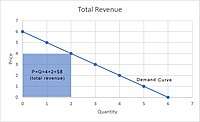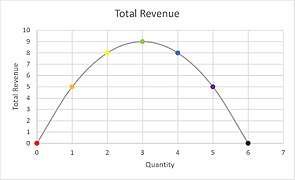Total revenue


Total revenue is the total receipts a seller can obtain from selling goods or service to buyers. It can be written as P × Q, which is the price of the goods multiplied by the quantity of the sold goods.
Definition
Total revenue is the total receipts a seller can obtain from selling goods or service to buyers. It can be written as , which is the price of the goods multiplied by the quantity of the sold goods. Total revenue also can be graphed as in Figure 1, in which Price (P) is the height of the box, and Quantity(Q) is the width. , (i.e., total revenue) equals the area of the box. Letting TR be the total revenue function: [1], where Q is the quantity of output sold, and P(Q) is the inverse demand function (the demand function solved out for price in terms of quantity demanded). Continuing to use Figure 1 as an example, price can be written as a function of quantity: , and be substituted into TR(Q) to get the TR function , which is a quadratic. In Figure 2 - Figure 4, this function is showed graphically by using an example of demand for apples. The demand for apples drops as the price increases, which leads to the changes of the total revenue.



Relationship between total revenue and elasticity
The function of TR is graphed as a downward opening parabola due to the concept of elasticity of demand. When price goes up, quantity will go down, and vice versa. Whether the total revenue will grow or drop is the result of percentage change in prices and quantities. For example, total revenue will rise when the percentage increase for thequantity is larger than the percentage decrease in price. The percentage change in the price and quantity determine whether the demand for a product is elastic or inelastic.
The changes in total revenue are based on the price elasticity of demand, and there are general rules for them:[2]
- Price and total revenue have a positive relationship when demand is inelastic (price elasticity < 1), which means that when price increases, total revenue will increase too.
- Price and total revenue have a negative relationship when demand is elastic (price elasticity > 1) , which means that increases in price will lead to decreases in total revenue.
- Price changes will not affect total revenue when the demand is unit elastic (price elasticity = 1). Maximum total revenue can be achieved when the elasticity of demand is 1.
Change in supply also can change the total revenue based on different elasticity of demand:
- When demand is inelastic, an increase in supply will lead to a decrease in total revenue while a decrease in supply will lead to an increase in total revenue.
- When demand is elastic, an increase in supply will lead to an increase in total revenue while a decrease in supply will lead to a decrease in total revenue. Rational people and firms are assumed to make the most profitable decision, and total revenue helps firms to make these decisions because the profit that a firm can earn depends on the total revenue and the total cost. There are two different kinds of profit: accountant profit (total monetary revenue - monetary costs) and economic profit ( total monetary revenue - monetary costs and opportunity costs a firm pays), which are both results of the total revenue. Profit used in economics is mostly economic profit: economic profit = total revenue - total cost.[3]
Relationship between total revenue and operational decision
Total revenue can help with a firm's operational decision: whether the firm should be shut down or kept open. There are two rules to follow:
1. If the total revenue(TR) that a firm can earn from operating will not exceed the variable costs (VC) of operation, the firm should be shut down.
If TR < VC, shut down.
2. If the result of dividing the total revenue by the quantity is less than the number obtained from dividing the variable cost by the quantity, then the firm should be shut down.
If TR/Q < VC/Q, shut down.
In the long run, these rules also can be applied when a firm needs to decide whether it should enter or exit a market:
If TR < VC, exit the market.
If TR/Q < TC/Q, exit the market.
The rules are opposite for entering a market.
If TR > VC, enter the market.
If TR/Q > TC/Q, enter the market.
Total revenue in monopoly
When it comes to the monopoly market, due to a special characteristic of monopoly——i.e., if a monopoly produces 1 additional unit, the price must be reduced for every unit it sells——the total revenue can be affected by two effects: the output effect, which means the total revenue will increase if firms can sell more output, and the price effect, which means the total revenue will decrease if the price decreases. Monopoly does not have a supply curve, so the total revenue depends completely on the demand curve and the marginal cost.
See also
References
- ↑ Mankiw, N. Gregory (2013). Principles of Microeconomics, 7e. USA: Cengage Learning. pp. 94–98, 106–107, 260–262, 283-288 & 304-308. ISBN 978-1-285-16590-5.
- ↑ Khan, Sal. "Total revenue and elasticity (video) | Khan Academy". Khan Academy.
- ↑ Case, Karl E.; Fair, Ray C.; Oster, Sharon M, (2014). Principles of Microeconomics 11th edition. England: Pearson. pp. 138–139, 180-181 & 306-307. ISBN 0-273-79004-8.